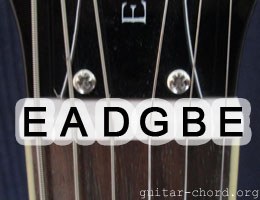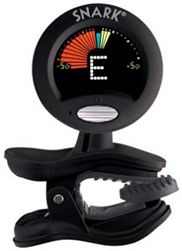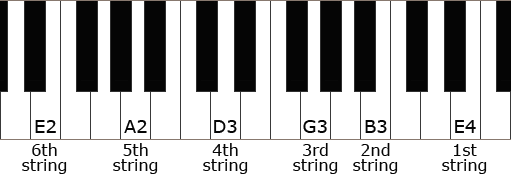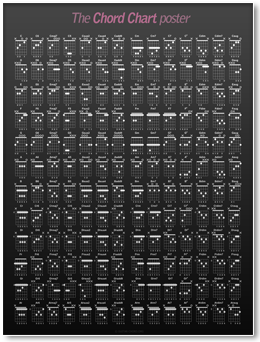Standard tuning on the guitar (EADGBe)
 The guitar is normally tuned EADGBe on the pitch standard A440, which is 440 Hz frequency. This means that the notes from lowest to the highest strings sound as the tones e, a, d, g, b and e (see picture) and if you are using an electronic tuner it's recommended that you use 440 Hz.
The guitar is normally tuned EADGBe on the pitch standard A440, which is 440 Hz frequency. This means that the notes from lowest to the highest strings sound as the tones e, a, d, g, b and e (see picture) and if you are using an electronic tuner it's recommended that you use 440 Hz.
If you play guitar, you want it to be tuned just like that (there are also alternate tunings, more about that later). How you do it and why the guitar is tuned in this particular way are questions this article is trying to answer.
EADGBe is read from left to right as from the lowest (thickest) string to the highest (thinnest). The reason why the sixth string is written in small letters will be explained later.
How to tune the guitar
Now that you know which tone each string should sound like, you should tune the guitar thereafter. There are some methods to choose from.
1. Use an electronic tuner
 This is probably the easiest way, especially if you’re a beginner.
Nowadays, it has become popular with small electronic tuners that you can attach directly on the guitar head without a cable between. The picture to the right shows an example of a tuner of that kind, Snark SN-5 Tuner. Some guitars have a built-in electronic tuner, commonly placed on the side of the body.
This is probably the easiest way, especially if you’re a beginner.
Nowadays, it has become popular with small electronic tuners that you can attach directly on the guitar head without a cable between. The picture to the right shows an example of a tuner of that kind, Snark SN-5 Tuner. Some guitars have a built-in electronic tuner, commonly placed on the side of the body.
Using an electronic tuner is the simplest approach since you only have to pick a string and the tuner indicates which tone it is. You probably need to adjust the tuning pegs until the correct tone is matched.
To get a higher note, turn the pegs away from yourself and to get a lower note, turn the pegs towards you (assuming you have the guitar in your knee or in front of you). For example, if the display on the electronic tuner indicates D# you should turn the peg away from you (counterclockwise) to reach E.
If you have the option to choose among hertz frequencies, the recommended frequency is 440Hz.
How to turn the pegs:
1st string: A › A# › B › C › C# › D › D# › E ‹ F ‹ F# ‹ G ‹ G# ‹ A ‹ A# ‹ B
2nd string: E › F › F# › G › G# › A › A# › B ‹ C ‹ C# ‹ D ‹ D# ‹ E ‹ F ‹ F#
3rd string: C › C# › D › D# › E › F › F# › G ‹ G# ‹ A ‹ A# ‹ B ‹ C ‹ C# ‹ D
4th string: G › G# › A › A# › B › C › C# › D ‹ D# ‹ E ‹ F ‹ F# ‹ G ‹ G# ‹ A
5th string: D › D# › E › F › F# › G › G# › A ‹ A# ‹ B ‹ C ‹ C# ‹ D ‹ D# ‹ E
6th string: A › A# › B › C › C# › D › D# › E ‹ F ‹ F# ‹ G ‹ G# ‹ A ‹ A# ‹ B
The 6th string = the heaviest string
2. Tuning by ear
This can be done by playing on specific strings, for example the so-called 5th Fret Guitar Tuning Method, and get the right tune by comparing the sounds. The method can be quite difficult if you’re a beginner, but you can watch this video and listen to the notes and at the same time play the strings on your guitar and turn the tuning pegs until you get a similar sound.
3. Tuning to a keyboard
A third way is to compare the tones from the guitar strings to references on the piano keyboard. The image below illustrates the relationships.

The numbers indicate which octave on the keyboard the tone should be played. E2 will therefore be the e tone on the second octave and so on.
Short explanation of standard tuning
So why are e, a, d, g, b and e chosen to be standard for this instrument? It's plainly because it's suitable in many ways. It makes it easier to play chords in the most common keys and it's also beneficial for playing scales, partly because the distance between the lowest and highest strings is two octaves. In other words, the cause for the arrangement of the tuning is pragmatic.
As you may notice, it's easy to play open chords such as C, D, E, G, A, but to find open shapes near the nut for chords such as C#, D#, F#, G# and A# is much harder.
The names, or letters, of the guitar strings may confuse some. For instance, why is the second e written in small letters when the rest is written as capitals? This is done to distinguish them: the second e (the highest string) is two octaves above the other.
The octaves are as follows:
E – 2nd octave
A – 2nd octave
D – 3rd octave
G – 3rd octave
B – 3rd octave
e – 4th octave
This means that e on the 2nd octave, for example, has more bass sound than e on the 4th octave.
The intervals of the open tones on the guitar are perfect fourths in five cases and major third in one case:
E-A perfect fourth
A-D perfect fourth
D-G perfect fourth
G-B major third
B-e perfect fourth
The slight asymmetry is once again because of pragmatic reasons in the sense of playability.
History and development
It's not clearly known when the first six-string guitar was built, but according to most sources it happened in the late 18th century. Sometime in the beginning of the next century, the tuning based on EADGBe was established.
Over the years, many alternative tunings have emerged. Two of the more popular is Open D tuning and Open G tuning. As said earlier, the standard tuning is used because it generally offers most playability, but the use of alternate tunings is for creative reasons and have served many experimental guitarists. In some particular cases, the alternatives can be preferred, open tunings are for example more suitable for playing slide guitar than the standard.
Close related tunings
Sometimes guitarist chooses to tune down the strings one (a half step) or two steps (a whole step) in order to change the sound some – it gets somewhat mellow – and, perhaps, for the reason to lose the strings a little to make it easier to play. It can also be easier to sing in higher register with an Eb Ab Db Gb Bb Eb tuning.
Tune down 1/2 step:
6th string = Eb
5th string = Ab
4th string = Db
3rd string = Gb
2nd string = Bb
1st string = Eb
Tune down 1 step:
6th string = D
5th string = G
4th string = C
3rd string = F
2nd string = A
1st string = D
Any easier alternatives?
For the beginner, the standard EADGBe tuning is not necessary the most convenient. An alternate tuning like EADGBD could be easier to handle. For example, the G chord can be played with two instead of three fingers, which also is the case with some other common chords. Also, the Bm and F chord that is often played with bar chords in standard tunings could be played by shapes in open positions.
Some prefer the so-called Fourths tuning (EADGCF), which involve equal 4th intervals all the way through and by that make sight reading more straightforward.
However, since most songs and most information available about playing guitar is generally based on the standard EADGBe, the primarily recommendation is after all to use this tuning as a beginner.
Digital poster

The Chord Chart Poster includes a selection of the 100+ most important chords for guitar.